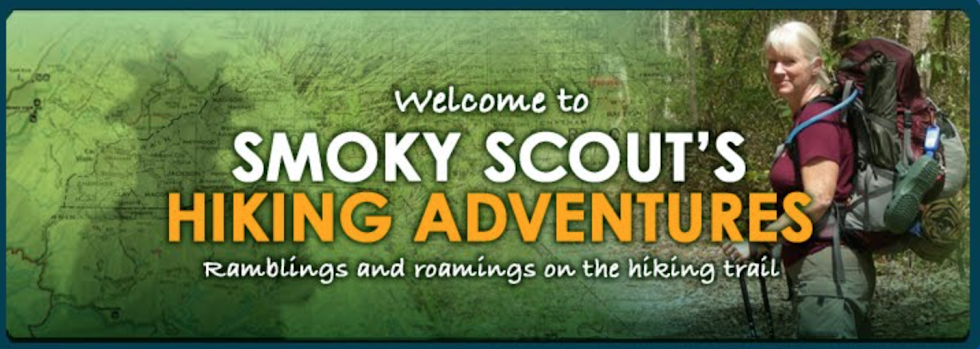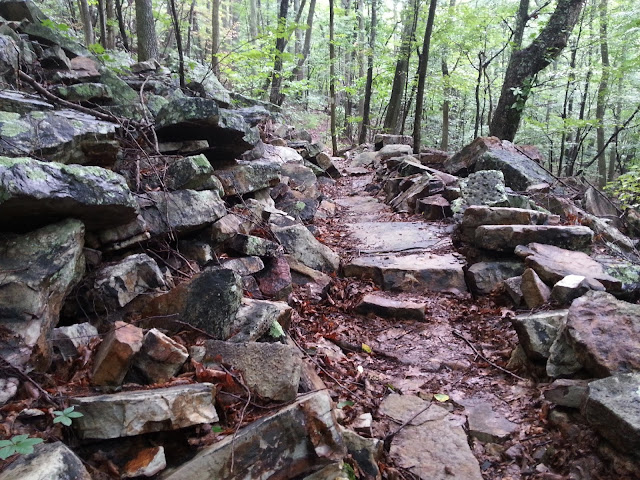Mount Noble Lookout Tower+ Barnett Knob Lookout Tower +
Mingo Falls + Soco Falls – 8/17/14 – 7.2 Miles
Do you always finish one book before starting to read another? Do you eat all of one delicious food on your
plate before eating the next (peas before mashed potatoes)? I like to complete one book before the next,
but sometimes I find myself with two or three going at once because (a) my turn
came up for a hard-to-get item at the library; (b) a friend handed me a book
and said, “Drop everything and read this NOW;” or (c) in the midst of something
heavy and complicated I needed a break with some chic lit.
You know I’m a hiking list person. Although I enjoy one-off trips to unique areas,
I appreciate lists and guidebooks that take me places that might not hit my
radar, on hikes that may be too short to warrant an overnight trip but can be
bundled together for a fun day in the same area. Western NC is chock-filled with waterfalls
and lookout towers that rise above the trees, most of them just a short walk
from the car. So in addition to larger
hiking projects like the Mountains-to-Sea Trail or the AT in Virginia, I keep
an eye on other lists to enhance a trip to the mountains (any mountains). Two great challenges are the Lookout Tower Challenge and the Waterfall 100 administered by Carolina Mountain Club.
The day after Jim’s big Blue Ridge Breakaway bike ride was a
perfect day for this type of exploration.
I narrowed down the list to two lookout towers and two waterfalls, all easy
hikes (well, except maybe the first one).
First up: Mount Noble Lookout
Tower in the CMC challenge created from Peter Barr’s book Hiking North Carolina’s Lookout Towers. This tower and the
Barnett Knob tower (which we visit later in the day) are the only two lookouts
on Cherokee Indian Reservation land today near Cherokee, NC.
Peter’s book includes exhaustive research on each tower’s
history, construction, current use status (most are inactive) and details of
the views. He also gives detailed
directions to trailheads and, where possible, multiple hikes to the
towers. Mount Noble Trail starts from
the Oconaluftee Indian Village parking area in Cherokee. We felt a little like trespassers on this
Sunday morning when the Village was closed.
If you’re in it just for the hiking, this trail is average. It is well-maintained but unsigned, so take
Peter’s hiking narrative with you. It’s
a steep, 2.4-mile trail weaving in and out of finger ridges until it hits a
gravel access road about a quarter mile from the tower. Keep in mind that most lookout tower
locations are now home to multiple communication monstrosities. The charm of a single tower on a mountaintop is
rare.
The most exciting thing about this hike today was this big
bad little garter snake on the trail.
Jim stepped over him unnoticed, but when I came along it
decided to stand its ground. It was
perhaps 18 inches long. After a few
minutes of mutual eyeballing, I realized he wasn’t giving up, so I flicked him
(gently) off the trail with my hiking pole.
C’est la vie.
Mount Noble Lookout Tower.
We couldn’t access the cab, just climbed as far as possible up the
stairs.
The view if you squint and look between the other junk. Unfortunately, I neglected to bring my copied pages of Peter’s description of the view
so I can’t identify the peaks.
On the return hike we got brave and took a scant trail that looked
like it went straight down a ridge rather than circling around for the first
half mile. Every few yards there were
trees tagged with orange flag tape. The tags
read “EBCI Survey, Do Not Disturb.” They
didn’t say “no trespassing” so we figured we were safe as long as we didn’t
touch. EBCI stands for Eastern Band of
Cherokee Indians.
Interesting gashes in the trees where the orange tape is tied
Second act: Mingo
Falls. We visited this waterfall
probably 20 years ago. It’s located just
a few miles from Oconaluftee Indian Village, heading out of town on Big Cove
Road. The walk to the falls is measured
in hundreds of yards, not miles, but involves some stair climbing to make you
feel you’ve put in some effort. A bridge
crosses in front for viewing from a safe distance, although there were some who scrambled on the rocks to get closer.
Mingo Falls: A near-vertical cascade about 150 feet tall.
On our way out a woman asked me if the walk was “worth it”
to see the falls. How do you answer such
a question? When is a walk in the woods
not worth it, even if there is no waterfall?
I always say emphatically, “Yes!”
Round three: Barnett
Knob Lookout Tower. The access road is
reached via the Blue Ridge Parkway as it descends through the Qualla Boundary to
its terminus at the entrance to the Great Smoky Mountains National Park. The hike is 1.2 miles round trip on a gravel
road that feels surprisingly steep, perhaps because it’s not a nice hiking
trail. This tower is still manned during
days of high fire danger.
Again, the tower is surrounded by lots of other steel
constructions.
But the view is pretty nice
Finale: Soco
Falls. Unlike Mingo Falls’ easy access,
Soco Falls seems like an accident waiting to happen. A few hundred yards off of twisty, busy U.S.
19, there are a few pull-off spaces with no visible signage. The trail looks like it was started with good
intentions down to a little viewing station, but there is also a steep scramble
where somebody has rigged up ropes for handrails and an honest-to-god rope to
swing down to the base of the waterfall.
Now, I am sometimes willing to take some risks, but seldom
if other people are around. I am not a
superior athlete, but I am pretty good at assessing risk. In this case, however, I didn’t realize how
precarious this system was until I was hanging on for dear life.
The falls were so loud we had to shout to be heard and it
felt glorious standing so close to all that power. As other people began to queue up for the
rope swing, we decided to leave before we were witness to a serious
injury.
An all-around great weekend where Jim and I engaged in the
outdoor activities we love, both separately and together. Moral of the story: wherever you are headed, look over your
lists, whether they are hikes or bike routes or wineries. Variety is the spice of life!
“I think that I cannot
preserve my health and spirits, unless I spend four hours a day at least - and
it is commonly more than that - sauntering through the woods and over the hills
and fields, absolutely free from all worldly engagements.” ~Henry David
Thoreau












































